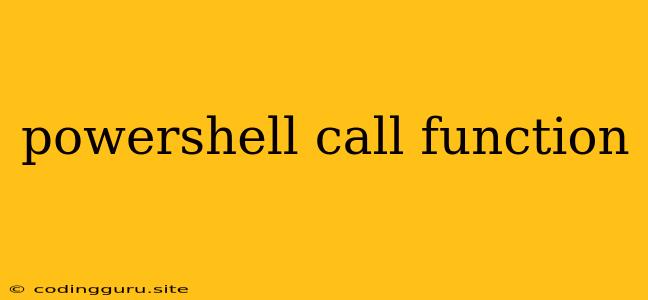How to Call Functions in PowerShell: A Comprehensive Guide
PowerShell is a powerful scripting language used for automating tasks within the Windows operating system. One of the key features of PowerShell is the ability to create and call functions. This allows you to break down complex tasks into smaller, reusable units of code, making your scripts more modular, maintainable, and efficient.
What are PowerShell Functions?
PowerShell functions are blocks of code that perform a specific task. They are defined using the function keyword followed by the function name and a set of curly braces {} enclosing the function's code. For instance:
function Greet-User {
Write-Host "Hello, $env:USERNAME!"
}
This code defines a function named Greet-User that writes a greeting message to the console, using the username stored in the $env:USERNAME environment variable.
How to Call a PowerShell Function
Once a function is defined, you can call it by simply typing its name followed by any necessary parameters:
Greet-User
This line of code will execute the Greet-User function, displaying the greeting message.
Passing Parameters to Functions
PowerShell functions can accept parameters, which are input values that modify the function's behavior. Parameters are defined within the function's definition, using the param() keyword:
function Greet-User {
param(
[string]$name
)
Write-Host "Hello, $name!"
}
This function takes a parameter named $name of type string. To call this function, you provide the value for the $name parameter:
Greet-User -name "John Doe"
This will output: "Hello, John Doe!".
Returning Values from Functions
PowerShell functions can also return values, which can be used by other parts of your script. This is achieved using the return keyword:
function Add-Numbers {
param(
[int]$num1,
[int]$num2
)
return $num1 + $num2
}
$sum = Add-Numbers -num1 5 -num2 10
Write-Host "The sum is: $sum"
This code defines a function Add-Numbers that takes two integer parameters and returns their sum. The returned value is then stored in the variable $sum and displayed on the console.
Advantages of Using PowerShell Functions
- Modularity: Functions break down complex tasks into smaller, reusable units, making your scripts more organized and easier to understand.
- Reusability: Functions can be called multiple times within a script or even from other scripts, reducing code duplication.
- Maintainability: Functions allow you to isolate changes to specific parts of your code, simplifying maintenance and debugging.
- Testability: Functions can be tested individually, making it easier to identify and fix errors.
Tips for Writing Effective PowerShell Functions
- Use descriptive function names: Choose names that clearly indicate the function's purpose.
- Document your functions: Add comments to explain what the function does, its parameters, and its return value.
- Use meaningful parameter names: Avoid using cryptic abbreviations or generic names like
$aor$b. - Validate function input: Check the validity of parameters before using them within the function's code.
- Keep functions concise: Aim to have functions perform a single, well-defined task.
Example Use Cases for PowerShell Functions
- Automating file management: You can create functions to copy, move, rename, or delete files based on specific criteria.
- Managing Active Directory objects: You can create functions to create, modify, or delete users, groups, or computers in Active Directory.
- Customizing system configuration: You can create functions to configure network settings, services, or other system components.
- Performing data analysis: You can create functions to process data from files or databases, perform calculations, and generate reports.
Conclusion
PowerShell functions are a fundamental building block for creating powerful and efficient scripts. By understanding how to define, call, and manage functions, you can significantly improve the modularity, reusability, and maintainability of your PowerShell code. By implementing these best practices and exploring their various use cases, you can harness the full potential of PowerShell functions to automate complex tasks and streamline your workflow.
